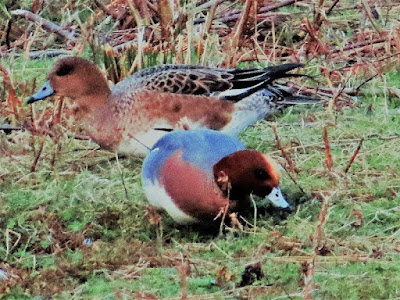A drake Gadwall of course.
Here a duck Gadwall is hauled out. This bird has less orange tones to the edges of her bill than is usual for this species.
This duck Gadwall (here with two drakes) shows a more typical bill colour.
A drake Gadwall flaps to remove water after a bathe. Note the black bill. Here the wings look rather stubby but it must be an optical illusion...
..as with this duck doing the same the wings look quite normal.
A trio of (Eurasian) Wigeon with two drakes at the back
A pair of Wigeon, here in the shade. Note both sexes have a black-tipped blue-grey bill and white bellies. The dark area around the eye of the duck is a feature unique to wigeon - 'our' species and the New World species of American Wigeon. In that species the drake has a white rather than yellow forehead. As a result one of its local names is Baldpate.
A pair of Teal in the foreground. Compare their size with that of the larger female Gadwall behind them. On the duck Teal note the green in the wing (the speculum) and also the white on the side of the tail. This white mark is visible at long range even if the wing is neatly folded and the green does not show.
A smart drake Teal glides by.
This Great Egret (yellow bill) remained semi-hidden throughout.
The unexpected bird of the day was this first-winter Black-tailed Godwit – identified as this age by the retained dark-centred and white-fringed flight feathers. On an adult all the feathers would look much like those on its back. The black tail is visible as it pivots to feed.
A size comparison with a pair of Teal. On the godwit note the two-tone bill.
On its own here. The beige wash on the breast and flanks will moult to become speckled black and richly rufous in the breeding season, though probably not this year for this immature bird.
Some days there are as many as 30 assorted age Cormorants coming and going. These mostly arrive and depart in the distance. This adult came closer to the hide and turned its wing-tips up as it passed by. No sign of any breeding plumage on this bird.
A Grey Heron in breeding condition with plumes hanging from its back and with the bill having lost all black markings. In the foreground are two duck Wigeon (with pale bellies) and a duck Teal tail on. Top right is a drake Teal. Top left is part of a duck Mallard from the leg colour.
It is not all waterbirds. There is a feeding station inside trees where the usual array of tits and finches gather. There it is too dark for photography in winter, even on sunny afternoons. In the open a few Goldfinches were extracting seeds, mainly from teasel heads. Not sure what plant these smaller heads are from.















